In the Moment:
Michael Frye's Landscape Photography Blog
by Michael Frye | Oct 27, 2013 | Advanced Techniques, Photography Tips
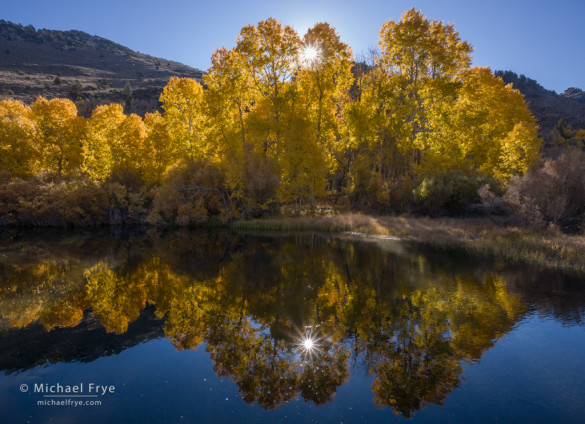
Aspens and morning sunlight, Inyo NF, CA, USA
I’ve always felt that the best photographs capture a mood or feeling. It’s easier to convey a mood when the weather gets stormy, but how do you capture a mood on a clear, sunny day? The answer, I think, is to go with it—to emphasize the sun, the blue sky, and the brightness of the day. Find the visual elements that say “beautiful, sunny day,” and highlight them.
One way of doing this is to include the sun in the frame. Nothing says “sunny and bright” like the sun itself. But putting the sun in your photograph brings challenges. First, you’re likely to get lens flare. This is not the end of the world—in fact, many photographs use lens flare to great effect—but sometimes the flare can be distracting. The other challenge is getting the exposure right.
(more…)
by Michael Frye | Oct 25, 2013 | Yosemite Photo Conditions
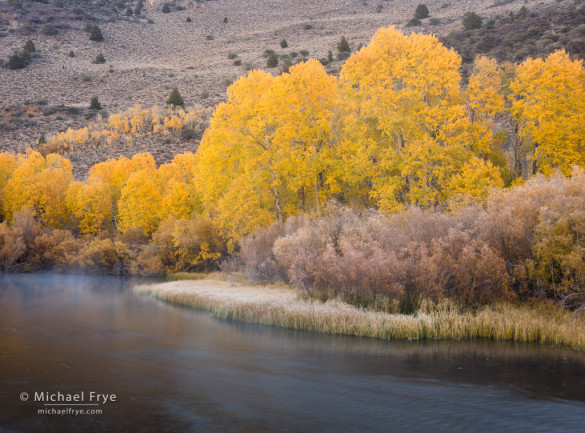
Autumn along a creek in the eastern Sierra Nevada, Inyo NF, CA, USA
I just returned home after spending nearly two weeks on the eastern side of the Sierra. It was fun spending so much time among all the yellow and orange leaves, and we had two wonderful groups for our workshops.
We had cooler-than-average weather in September and early October, which set things turning early this year. Despite that, there was still a lot of color around the June Lake Loop and lower Lundy Canyon when we left on Wednesday. This image, from Wednesday morning, shows the diversity of eastern-Sierra habitats, with a creek, aspens, willows, and sagebrush-covered hillside.
(more…)
by Michael Frye | Oct 20, 2013 | Digital Photography Basics
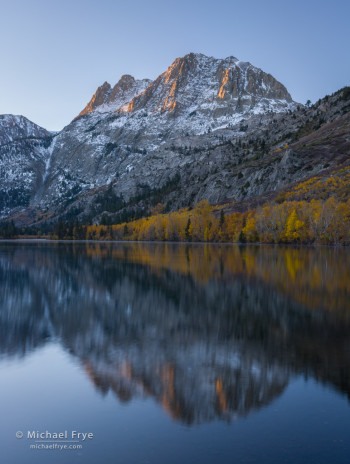
Sunrise on a peak in the eastern Sierra, Inyo NF, CA, USA
I made this photograph yesterday morning during my first Eastern Sierra Fall Color workshop. It’s just so beautiful over here! We had a great time, and I’m looking forward to the second one.
With sidelight like this, a polarizing filter can actually lighten a reflection if it’s adjusted correctly. By lightening the refection and darkening the sky the polarizer helped to balance the contrast of this scene, and from there it was relatively easy to process this image in Lightroom using Highlights, Shadows, and the Graduated Filter tool.
— Michael Frye
Related Posts: A Landscape Transformed; Autumn Snow
Did you like this article? Click here to subscribe to this blog and get every new post delivered right to your inbox!
Michael Frye is a professional photographer specializing in landscapes and nature. He is the author or principal photographer of The Photographer’s Guide to Yosemite, Yosemite Meditations, Yosemite Meditations for Women, and Digital Landscape Photography: In the Footsteps of Ansel Adams and the Great Masters. He has also written three eBooks: Light & Land: Landscapes in the Digital Darkroom, Exposure for Outdoor Photography, and Landscapes in Lightroom 5: The Essential Step-by-Step Guide. Michael written numerous magazine articles on the art and technique of photography, and his images have been published in over thirty countries around the world. Michael has lived either in or near Yosemite National Park since 1983, currently residing just outside the park in Mariposa, California.
by Michael Frye | Oct 13, 2013 | Photography Tips
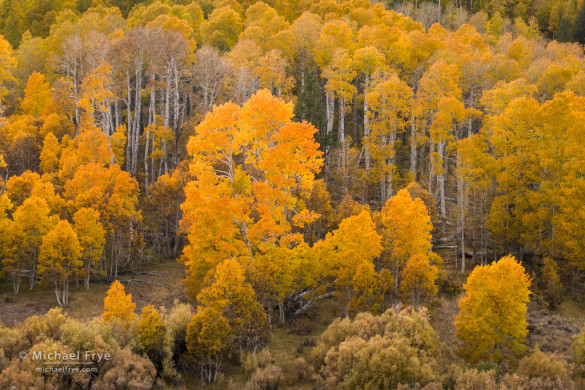
Autumn aspens, Conway Summit, Inyo NF, CA, USA
Here are two photographs I made last week near Conway Summit on the eastern side of the Sierra. The first one, above, is from Tuesday afternoon, with soft backlight filtering through thin clouds and making the leaves glow. The second image, below, was made Wednesday morning under overcast skies as the snow started to fall. I used a fast shutter speed (1/90th sec.) to freeze the motion of the snowflakes, which created a faint white dot pattern across the frame.
(more…)
by Michael Frye | Oct 11, 2013 | Yosemite Photo Conditions
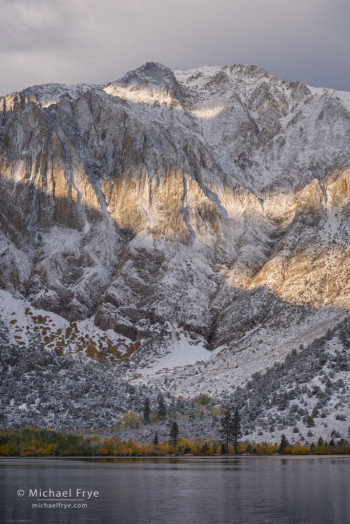
Bands of sunlight on Laurel Mountain from Convict Lake, Inyo NF, CA, USA
On Tuesday Claudia and I headed over Tioga Pass to Lee Vining. Forecasts called for snow above 7000 feet on Wednesday, so we were trying to get over the pass before the road closed to photograph the snowstorm and its aftermath.
And snow it did. Five or six inches fell at higher elevations on Wednesday, covering the mountains, pines, and aspens. I was like a kid in a candy store; I saw photographs everywhere I looked. I haven’t had time to process or post anything until now because I’ve been spending every spare minute behind the camera, but here are two images from Thursday morning at Convict Lake, and I’ll post more when I get the chance.
Tioga Pass reopened today, so we’re headed back home to Mariposa for a couple of days, but so far the cold and snow haven’t adversely affected the aspens. While the color at some of the higher elevations areas is past peak, many of my favorite lower-elevation areas like June Lake Loop and Lee Vining Canyon still have a mix of green and yellow leaves, so it looks like the color should last a while longer.
— Michael Frye
Related Post: Signs of Autumn
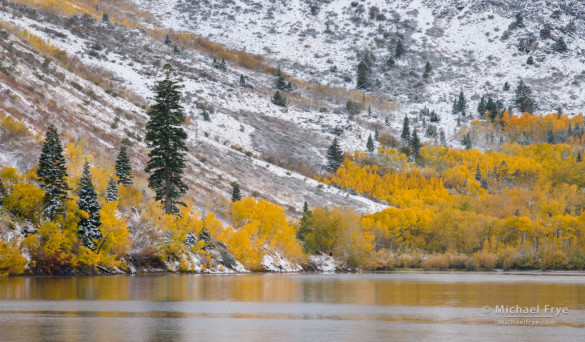
Autumn color along the shore of Convict Lake, Inyo NF, CA, USA
(more…)
by Michael Frye | Oct 2, 2013 | Digital Darkroom
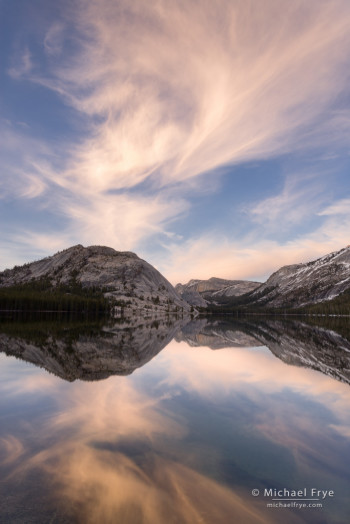
Sunset clouds, Tenaya Lake, Yosemite NP, CA, USA
Back in June I wrote about Adobe’s new subscription-only model for licensing Photoshop, called the Creative Cloud. Let’s just say that I wasn’t happy about it. But recently, as I’m sure many of you know, Adobe announced a new Photoshop Photography Program. For $9.99 per month you can get both Photoshop CC (Creative Cloud) and Lightroom, and it’s not an introductory price that will go up after a year. That doesn’t mean that it will never go up, but Adobe says that they don’t have any plans to increase the price at this time. (The offer is only available to people who currently own Photoshop CS3 or later, and it expires on December 31st.)
I have to say that this is a more attractive offer. $9.99 per month comes out to less than I’ve been paying for upgrades to both Lightroom and Photoshop. Of course I already own a license to Lightroom 5, so in the short term I’d really be paying just for Photoshop CC. But at least the price wouldn’t automatically go up after a year, and when Lightroom 6 comes out I’d get it for no extra charge.
Unfortunately this program won’t help you if you don’t already own Photoshop CS3 or later. It’s possible that Adobe might offer a version of this package (probably a more expensive version), to people who don’t already own Photoshop, but there’s no word of that yet. You can still buy Photoshop CS6 from places like Amazon and B&H, and that would then qualify you to get this Photoshop/Lightroom bundle, but that’s an expensive way to go, since CS6 is going for more than $600.
(more…)
by Michael Frye | Oct 1, 2013 | Announcements, Yosemite Photo Conditions
It’s official: the impasse in Washington has led to a government shutdown, and all national parks will be closed, including Yosemite. Apparently the Tioga Road will remain open to through traffic, but no parking will be allowed. “Through” roads are supposed to remain open, but it’s unclear at this point whether that means any other roads will be open in Yosemite besides the Tioga Road. Visitors staying in campgrounds or hotels within the park will have 48 hours to vacate.
There’s not much information coming from the park, no doubt because most of the park service employees have just been furloughed! I’ll let you know if I get any further information.
— Michael Frye
by Michael Frye | Sep 30, 2013 | Digital Darkroom
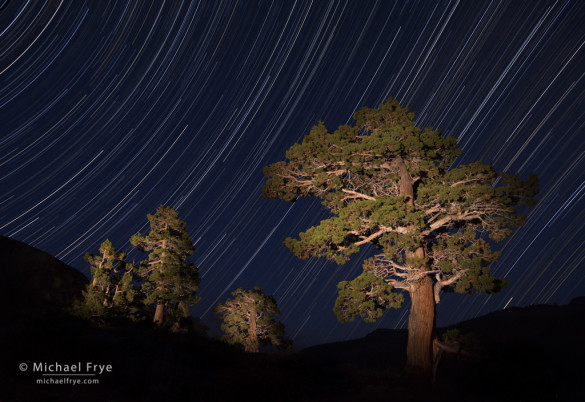
Star Trails and junipers east of Sonora Pass. Lightroom’s retouching tools keep getting more sophisticated; Lightroom 5’s Advanced Healing Brush was very helpful in removing jet trails from this image.
Adobe just released Lightroom 5.2, with a small but significant new feature: the ability to add feathering to the Spot Removal Tool’s brush. This adds further sophistication to Lightroom’s retouching abilities, continuing the theme introduced by the “Advanced Healing Brush” in Lightroom 5.0.
You usually want fairly hard-edged brushes with retouching tools, otherwise you’ll get unwanted blurring along the borders of your retouching areas. But small amounts of feathering can help make transitions smoother and the retouching less obvious. Try setting the Feathering in the Spot Removal Tool to 40 as a starting point, then modify it if necessary. And in keeping with Lightroom’s complete flexibility, you can adjust the feathering after the fact: you can place a spot or add a brush stroke, then adjust the feathering of that area to see the effect of different feathering amounts.
As I said, this is a small improvement, but a helpful one, and something worth paying attention to if you’re a Lightroom user. Naturally 5.2 is a free upgrade if you own Lightroom 5.
And while we’re on the subject, I’ve found the Advanced Healing Brush to be extremely helpful. This is a new capability added to the Spot Removal Tool in Lightroom 5.0, allowing you to brush over an area you want to retouch instead of using a series of discrete spots. It’s made my retouching in Lightroom more efficient, and allowed me to use Photoshop less and stay in Lightroom more. I’m curious about whether others have also found this new feature helpful—let me know how you like it.
— Michael Frye
(more…)
by Michael Frye | Sep 25, 2013 | Yosemite Photo Conditions
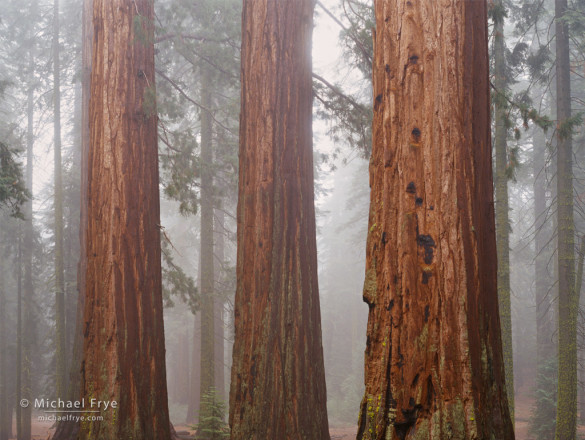
Giant sequoias in fog, Mariposa Grove, Yosemite NP, CA, USA
I thought this was an interesting story in the L.A. Times about efforts to save Yosemite’s giant sequoia trees and old-growth sugar pines during the Rim Fire. Sounds like it was quite dramatic (though perhaps the writer played up the drama a bit).
Today the fire is almost out. They’re still listing it as only 84% contained, but that’s because they’re letting it burn slowly into remote and rocky areas east of Cherry Lake and north of Hetch Hetchy. Elsewhere the fire is smoldering here and there within the containment lines, but rain and snow last Saturday doused a lot of that activity, and smoke from the fire has diminished greatly. All the main roads inside and outside the park are now open.
(more…)
by Michael Frye | Sep 24, 2013 | Yosemite Photo Conditions
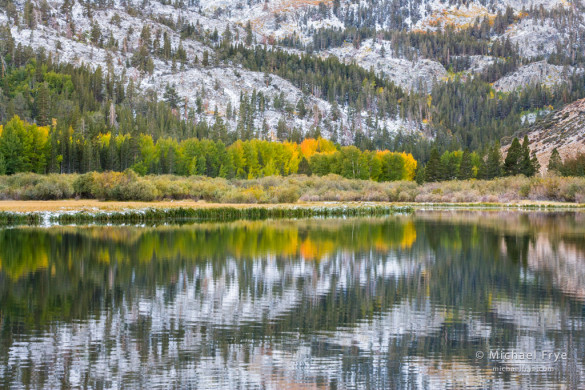
Reflections in North Lake on Sunday morning after a dusting of snow, Inyo NF, CA, USA
Last weekend my wife Claudia and I made our annual pilgrimage to the Millpond Music Festival in Bishop, over on the eastern side of the Sierra Nevada. We had a wonderful time, as usual; this is either the 14th or 15th consecutive year we’ve attended this event, so clearly we love it.
On the drive over we could see some color changes starting to appear in the highest aspen groves, like where Warren Canyon meets Lee Vining Canyon along Highway 120 east of Tioga Pass, and on the higher reaches of the Parker Bench, above the northern end of the June Lake Loop just southeast of Parker Lake.
Saturday evening it sprinkled in Bishop, and further north several inches of snow fell on Tioga Pass and Sonora Pass, temporarily closing both routes. I knew that the nearby upper reaches of Bishop Creek Canyon would likely have a dusting of snow in the morning, and I’d heard that the colors were already changing up there, so I rose early Sunday and drove up to North Lake before sunrise.
(more…)


















